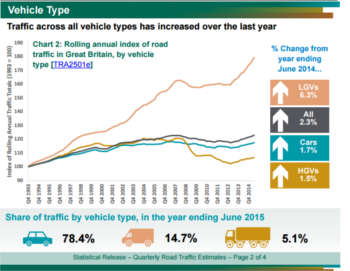Motor traffic in Britain rose to its highest rolling annual total ever in the year ending June 2015, based on provisional government estimates.
Latest statistics from the Department for Transport (DfT) state traffic in Great Britain increased by 2.3% in the year ending June 2015 from the previous year, with an above average share of this held by local roads.
Traffic increased by 5.5% on minor rural roads and by 2.5% on minor urban roads, although traffic on urban roads remains 3.9% below the pre-recession peak in 2007.
Overall traffic on motorways and rural roads was higher than ever before. As usual in recent years growth of light goods vehicle (LGV) traffic made up a large share of the overall traffic increase, rising by far more than any other mode at 6.3% on the previous year.

Source: DfT
‘The provisional figure of 314.6 billion vehicle miles is the highest rolling annual total ever, around 0.1% more than the pre-recession peak for the year ending September 2007,’ the report states.
RAC Foundation director and former director general of roads, traffic and local group at the DfT, Steve Gooding, told Transport Network: ‘We are about to put in our submission to the chancellor’s spending review and we call for more spending on local roads. I think these figures support that call.
‘We are worried about the condition of the local road network. There is a whole coalition of interest in the quality of local roads and it may seem counter-intuitive but it is cyclists and public transport who perhaps have most reason to be concerned.’
The report states: ‘The upward trend in traffic volumes is likely to reflect growth in the UK economy. GDP rose by 2.6%2 in the year ending June 2015. Lower fuel prices may also have contributed to increased traffic. The retail price of premium unleaded in the year ending June 2015 was on average 12.6 pence per litre cheaper than in the previous year.’
Gooding added: ‘Advocates of peak car can see all sorts of trends such as the increase in the age of people taking driving tests. But I personally am sceptical when we know population is set to rise in this country and particularly when the pattern of new housing being built is in places where people can be car dependent.’
Claire Francis of sustainable transport charity, Sustrans, said: ‘Unfortunately the consequences will include increased congestion, less active travel and worse air quality. At a time when the pressure on the NHS is growing, surely we should be doing all we can to reduce our reliance on motor vehicles and put serious investment into walking and cycling?’
However Gooding pointed to the increase in out of hours LGV deliveries as a good thing that is making more use of the road network and helping spread the effects of congestion.
‘This is mainly an online phenomenon. We all know some of the problems delivering goods to work and to home during the day. We are likely to see an increase in businesses or services providing evening deliveries or pick up points as Transport for London has done for its stations. We may end up recreating the post box for the modern age.’
Compared to the previous year, in the year ending June 2015:
- Car traffic increased by 1.7%
- Van traffic continued to rise faster than any other vehicle type, increasing by 6.3% to a new peak of 46.3 billion vehicle miles
- All road classes experienced higher volumes of traffic, with traffic on rural minor roads increasing the fastest, at 5.5%
- Motorway traffic increased by 1.8%, reaching 65 billion vehicle miles The quarterly estimates are provisional with annual estimates for 2015 due to be published in summer 2016.